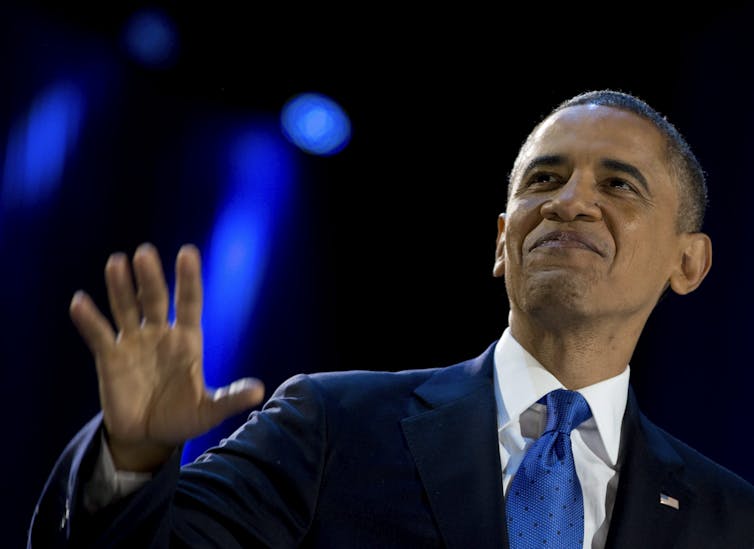U.S. President Joe Biden mingles with diners at Hannibal’s Kitchen in Charleston, S.C., in January 2024. (AP Photo/Stephanie Scarbrough)
Matthew Lebo, Western University
As 2024 begins, Joe Biden’s hopes of being re-elected president of the United States look shaky. Recent approval ratings have him at 39 per cent, consumer sentiment on the economy sits near a 10-year low and early polls have him down about two points in a hypothetical rematch with Donald Trump.
How worried should Democrats be?
Several historical patterns are relevant and work in Biden’s favor.
Democrats gripe, then return
First, in seven of the last eight presidential elections, the Democrat has won more votes. The Electoral College aside, American voters lean Democratic.
Also, they don’t give up on a president very often. Since 1896, the only presidents to have taken over from the opposing party and then lost re-election were Jimmy Carter in 1980 and Trump in 2020. Unless things are going very badly, re-election of a president is the most likely outcome.
Biden’s current polling doesn’t tell the whole story of his chances. For one, a poll’s timing should affect what we infer from it. Approval ratings in January of an election year don’t reflect the support that will likely exist in November.
Biden’s approval rating is 78 per cent among Democrats, but those numbers will likely improve by November if the re-elections of both Barack Obama and Bill Clinton are any indication.
On Jan. 1, 2012, 76 per cent of self-identifying Democrats approved of Obama’s job performance. By the week of the 2012 election, it was 91 per cent. Ninety-two per cent of Democrats voted for him in 2012.

President Barack Obama looking up at the cheering crowd at the election night party at McCormick Place in Chicago on Nov. 7, 2012. (AP Photo/Carolyn Kaster)
Similarly, Clinton’s January 1996 approval rating among Democrats was 72 per cent, but 86 per cent by the time the election was held.
Democrats are more likely to express dissatisfaction with their own presidents, but they return to the fold. That’s because months before an election, disapproval is an easy way for Democrats to relate their misgivings about their candidate.
As the year progresses, approval becomes more about the choice between their team’s candidate and the opposition. Campaigns ramp up partisanship later in an election year, and that hasn’t really begun yet.
Too soon
Another hidden pocket of Biden support is among voters who are neither Democrats nor Republicans. Self-described independents’ approval of Biden is just under 30 per cent, but they preferred him to Trump by 52 per cent to 43 per cent in 2020. More than 30 per cent are likely to choose Biden this November.
Biden versus Trump polls this early are likely poor predictors of what’s to come, especially with a president running for re-election. The incumbent party candidate is known, while the media focuses on the debates and primaries of the other party.
In every January of an election year, it’s still not clear who will be the successful challenger to the president in November. Questions about hypothetical match-ups are more about a referendum on the president — whether they deserve re-election or how they compare to some possible alternative.

Former president Donald Trump thanks supporters who cheered him after he held a news conference following the final arguments in his fraud trial in New York on Jan. 11, 2024. His son Eric smiles behind him. (AP Photo/Mary Altaffer)
But as the year progresses and the opposition candidate is chosen, survey respondents focus more on the choice between candidates on Election Day.
Right now, disappointed liberals, some independents and Democrats who are worried about Biden’s age (or Vice-President Kamala Harris waiting in the wings) may tell pollsters they would vote for another candidate. But most will probably come back to Biden.

Trump and Biden participate in the final presidential debate in Nashville, Tenn., in October 2020. (AP Photo/Patrick Semansky)
A highly unusual election year
Still, 2024 is anything but typical.
In a routine re-election year, it takes time for voters to form opinions about the challenger. Voters already know Trump, who’s the first former president since Teddy Roosevelt in 1912 to seek the office again. Roosevelt lost, incidentally.
Also, a second Biden-Trump showdown would be the first rematch since Adlai Stevenson lost for a second time to Dwight Eisenhower in 1956. If Trump is the nominee, voters will have well-defined opinions of both candidates already.
Worries about Biden’s age will be thought of more comparatively — Trump would be older at his second inauguration than Biden was at his first. Voters can also compare Biden’s economic record (400,000 jobs/month) to Trump’s (176,000 jobs/month prior to the COVID-19 pandemic).
Also, Trump’s interweaving of campaigning for president while fighting court battles in four jurisdictions will provide a daily contrast to Biden. A recent Washington Post poll found 56 per cent of respondents think Trump is probably or definitely guilty of criminal conspiracy regarding his claims of voter fraud and efforts to overturn the 2020 election.
Legal experts suggest Trump will probably be convicted this year on some charges. The Supreme Court may even disqualify him from running, though that’s less likely.

U.S. President Joe Biden mingles with diners at Hannibal’s Kitchen in Charleston, S.C., in January 2024. (AP Photo/Stephanie Scarbrough)
Be skeptical of polls for now
With 2020 as a baseline, we know a lot about how voters will choose between Trump and Biden. With strong polarization between the parties, significant movement from the 2020 results will be unlikely.
Biden’s victory by seven million votes included the key states of Arizona, Michigan, Wisconsin, Pennsylvania, Nevada and Georgia. That was good for 306 of 538 electoral votes.
The president could lose several of those swing states in 2024 and still prevail. Mid-terms in 2022 brought in many new voters — younger and pro-choice — who will likely add to that small cushion.
There are many unknowns for 2024, and Trump is not yet the Republican nominee. But in a Trump versus Biden rematch, not much will have changed and a similar result is most likely: a big Biden vote lead and tight state-by-state battles.
Don’t believe all the numbers just yet.
Matthew Lebo, Professor and Chair, Department of Political Science, Western University
This article is republished from The Conversation under a Creative Commons license. Read the original article.

